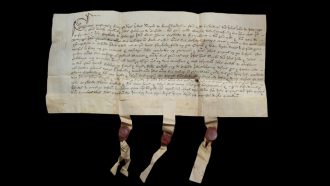
Fraudulent efforts to tweak legal documents in Great Britain may have been thwarted by the very parchment those documents were written on, a new study suggests.
Previous studies have shown that property deeds were written on a range of animal skins, such as goat, calf and sheep. But it turns out sheepskin was the parchment of choice, researchers report March 24 in Heritage Science. An analysis of proteins extracted from 645 samples from 477 British legal documents dating from the 16th to the 20th century shows that 622, or 96.4 percent, contained sheepskin.
That popularity may be tied to low cost compared with other parchments, like vellum made from calfskin, as well as sheepskin’s fraud-busting powers.
To make parchment out of animal skin, the skins are submerged in lime, a white powdery caustic soda, which removes the fat. Sheepskin has more fat — accounting for 30 to 50 percent of its weight — than other animal skins. (Cattle skin, for instance, is 2 to 3 percent fat.) So its removal leaves bigger gaps between the skin’s other layers. Scraping ink from this parchment can detach these loose layers, marring the surface and revealing changes to it.
“We know so little about these documents, despite the fact that there are millions worldwide,” says study coauthor Sean Doherty, an archaeologist at the University of Exeter in England. Studies like these, Doherty says, “are transforming libraries into biomolecular archives,” which are allowing researchers to better understand animals, craft and trade over the past millennia.
Several 12th and 17th century documents describe sheepskin as useful in detecting changes to an original document, such as tampering with a property owner’s name. The new study adds to evidence that sheepskin helped to prevent fraudsters from pulling the wool over English officials’ eyes.

 A new treatment could restore some mobility in people paralyzed by strokes
A new treatment could restore some mobility in people paralyzed by strokes  What has Perseverance found in two years on Mars?
What has Perseverance found in two years on Mars?  This robot automatically tucks its limbs to squeeze through spaces
This robot automatically tucks its limbs to squeeze through spaces  Greta Thunberg’s new book urges the world to take climate action now
Greta Thunberg’s new book urges the world to take climate action now  Glassy eyes may help young crustaceans hide from predators in plain sight
Glassy eyes may help young crustaceans hide from predators in plain sight  A chemical imbalance doesn’t explain depression. So what does?
A chemical imbalance doesn’t explain depression. So what does?